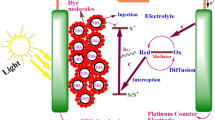Abstract
The effect of different compositions (in weight percent) of ethylene carbonate (EC) and propylene carbonate (PC) containing iodide/triiodide redox electrolyte on the photoelectrochemical performance of N719-sensitized nanocrystalline TiO2 solar cell was studied. The cells consisted of 0.6 M 1-hexyl-2,3-dimethylimidazolium iodide, 0.1 M LiI, 0.05 M I2 and 0.5 M 4-tert-butylpyridine in different compositions such as 1:1, 1:2, and 2:1 wt% of EC and PC. In 1:1 wt% of EC and PC containing redox electrolyte, short circuit photocurrent density (J sc) increased and open circuit voltage (V oc) decreased. But in 1:2 and 2:1 wt% of EC and PC containing redox electrolytes, V oc increased and J sc decreased but fill factor remained relatively constant. Dye-sensitized solar cells (DSSCs) prepared using these electrolytes give a short circuit photocurrent densities of 16.86, 12.71, and 12.09 mA/cm2; an open circuit voltages of 0.73, 0.78, and 0.79 V; fill factors of 0.63, 0.64, and 0.64; and an overall conversion efficiencies of 7.76, 6.34, and 6.13 % at an incident light of 100 mWcm−2 for 1:1, 2:1, and 1:2 wt% of EC/PC containing redox electrolytes, respectively. The incident photon-to-current conversion efficiency was higher in the case of 1:1 wt% of EC and PC containing redox electrolyte than 1:2 and 2:1 wt% of EC and PC containing redox electrolyte. It revealed that 1:1 wt% of EC and PC containing iodide/triiodide redox electrolyte is an effective electrolyte system for the fabrication of long-term stable DSSC.



Similar content being viewed by others
References
McConnell RD (2002) Assessment of the dye-sensitized solar cell. Renew Sust Energ Rev 6:273
Gratzel M (2001) Photoelectrochemical cells. Nature 414:338
Qin Q, Tao J, Yang Y (2010) Preparation and characterization of polyaniline film on stainless steel by electrochemical polymerization as a counter electrode of DSSC. Synth Met 160:1167
Ki Seob H, Seok Joo D, KiRyong H (2011) Photovoltaic efficiency characteristics of DSSC with electroplated Pt/Ni counter electrode. Appl Chem Engg 22:98
Yu B, Noh Y, Han J, Song O (2011) MWCNT employed counter electrode for DSSCs. IEEE nanotechnology materials and device conference at University of Seoul, Dongdaemun-gu, South Korea 18–21 Oct. 2011
Daeneke T, Uemura Y, Duffy NW, Mozer AJ, Koumura N, Bach U, Spiccia L (2012) Aqueous dye-sensitized solar cell electrolytes based on the ferricyanide–ferrocyanide redox couple. Adv Mater 24:1222
Gibson EA, Le Pleux L, Fortage J, Pellegrin Y, Blart E, Odobel F, Hagfeldt A, Boschloo G (2012) Role of the triiodide/iodide redox couple in dye regeneration in p-type dye-sensitized solar cells. Langmuir 28:6485
Yingtong T, Xu P, Changneng Z, Songyuan D, Fantai K, Linhua H, Yifeng S (2010) Influence of different electrolytes on the reaction mechanism of a triiodide/iodide redox couple on the platinized FTO glass electrode in dye-sensitized solar cells. J Phys Chem B 114:4160
Mingkui W, Nathalie C, Livain B, Jacques-E M, Robin H-B, Benoît M, Zakeeruddin SM, Michael G (2010) An organic redox electrolyte to rival triiodide/iodide in dye-sensitized solar cell. Nat Chem 23:85
Gubbala S, Chakrapani V, Kumar V, Sunkara MK (2008) Band-edge engineered hybrid structures for dye-sensitized solar cells based on SnO2 nanowires. Adv Func Mater 18:2411
Fukui A, Komiya R, Yamanaka R, Islam A, Han L (2006) Effect of a redox electrolyte in mixed solvents on the photovoltaic performance of a dye-sensitized solar cell. Sol Energy Mater Sol Cells 90:649
Vendra V, Nyugen T, Amos DA, Druffel T, Sunkara MK (2012) Alternate redox couples in dye sensitized solar cells using tin oxide nanowires and their hybrid architectures. The Electrochemical Society Meeting Abstract, Honolulu, Hawaii 7 – 12 Oct 2012
Gerrit B, Anders H (2009) Characteristics of the iodide/triiodide redox mediator in dye-sensitized solar cells. Acc Chem Res 42:1819
Bo-So C, Kellen C, Yi-Huan H, Wei-Hsin L, Tsung-Hui L, Chin-Hung L, Pi-Tai C, Yun C, Lee G-H (2009) Neutral, panchromatic Ru(II) terpyridine sensitizers bearing pyridine pyrazolate chelates with superior DSSC performance. Chem Commun 5844:106
Viswanathan SS, Myoungho P (2010) Effect of coadsorbents on DSSC sensitized by NIR absorbing poly(ethyl thieno[3,4-b]thiophene-2-carboxylate). Curr Appl Phys 10:S410
Zhen F, Aaron AE, Kirk SS (2011) Low-bandgap donor−acceptor conjugated polymer sensitizers for dye-sensitized solar cells. J Am Chem Soc 133:3063
Huizhi Z, Liqiong W, Yurong G, Tingli M (2011) Dye-sensitized solar cells using 20 natural dyes as sensitizers. J Photochem Photobiol A Chem 219:188
Mi Yeon S, Do Kyun K, Kyo Jin I, Seong Mu J, Dong Young K (2004) Electrospun TiO2 electrodes for dye-sensitized solar cells. Nanotechnology 15:1861
Sathiyapriya AR, Subramania A, Young-Sam J, Kim K-J (2008) High-performance quasi-solid-state dye-sensitized solar cell based on an electrospun PVdF-HFP membrane electrolyte. Langmuir 24:9816
Hongxia W, Peter LM (2012) Influence of electrolyte cations on electron transport and electron transfer in dye-sensitized solar cells. J Phys Chem C 116:10468
Wu J, Lana Z, Wang D, Hao S, Lin J, Wei Y, Yin S, Sato T (2006) Quasi-solid state dye-sensitized solar cells-based gel polymer electrolytes with poly(acrylamide)–poly(ethylene glycol) composite. J Photochem Photobiol A Chem 181:333
Rajendran S, Sivakumar P (2008) An investigations of PVdF/PVC-based blend electrolytes with EC/PC as plasticizers in Lithium battery applications. Physica B 403:509
Wu J, Lan W, Hao S, Li P, Lin J, Huang M, Fang L, Huang Y (2008) Progress on the electrolytes for dye-sensitized solar cells. Pure Appl Chem 80:2241
Liu Y, Hagfeldt A, Xiao X-R, Lindquist S-E (1998) Investigation of influence of redox species on the interfacial energetics of a dye-sensitized nanoporous TiO2 solar cell. Sol Mater Sol Cell 55:267
Wiberg J, Marinado T, Hagberg DP, Sun L, Albinsson B (2010) Distance and driving force dependencies of electron injection and recombination dynamics in organic dye-sensitized solar cells. J Phys Chem B 114:14358
Acknowledgments
One of the authors (Dr. AS) gratefully acknowledge the CSIR, New Delhi for the financial support.
Author information
Authors and Affiliations
Corresponding author
Rights and permissions
About this article
Cite this article
Subramania, A., Vijayakumar, E., Sivasankar, N. et al. Effect of different compositions of ethylene carbonate and propylene carbonate containing iodide/triiodide redox electrolyte on the photovoltaic performance of DSSC. Ionics 19, 1649–1653 (2013). https://doi.org/10.1007/s11581-013-0892-3
Received:
Revised:
Accepted:
Published:
Issue Date:
DOI: https://doi.org/10.1007/s11581-013-0892-3




